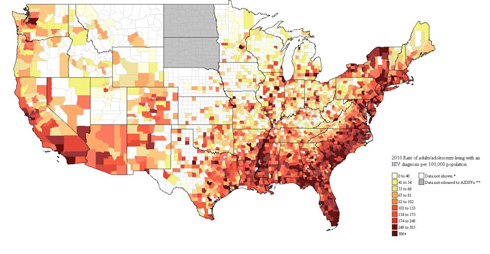The interactive mapping website AIDSVu.org launched an update of its online maps of the national HIV epidemic on June 27, National HIV Testing Day. The maps break down the latest HIV prevalence statistics for every state and county and for 20 cities by age, race, and mode of HIV transmission, providing the most detailed publicly available view of HIV in the U.S.

AIDSVu’s updated map of HIV prevalence in the U.S. by county. Photo courtesy of AIDSVu.
The site also features maps that include statistics on social factors known to contribute to HIV risk—including rates of poverty, high school education, median household income, percentage of people without health insurance, and income inequality—and shows how those factors correspond with HIV prevalence. For 20 urban HIV hubs, visitors can search HIV prevalence by zip code. They can also locate their local HIV testing and treatment site locations.
AIDSVu was created by the Rollins School of Public Health at Emory University “to make HIV prevalence data widely accessible and locally relevant” through “an intuitive way to connect with complex information about persons living with an HIV diagnosis.” The June 27 update added the latest CDC data, which is from 2010, and rolled out zip code-specific information for five new cities—Memphis, Orlando, San Diego, Tampa, and Virginia Beach. Zip code maps for Charlotte and Denver are scheduled to debut in August or September, bringing the number of featured cities to 22.
Visitors can also now view statistics on the social factors contributing to HIV side-by-side with the HIV prevalence by zip code for Atlanta, Philadelphia, and Washington D.C. Maps of the other featured cities that include these social determinants on a city-wide, though not zip code basis, will continue to be posted throughout the summer and fall, along with county maps that show HIV transmission mode statistics. Visitors can also now view state maps showing how HIV mortality rates vary by race. Visit AIDSVu.org today and see what HIV looks like in your community.